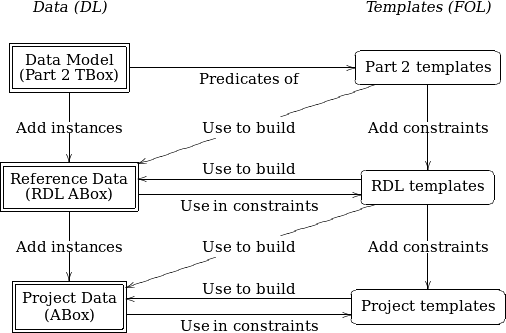| Version 7 (modified by onnopaap, 12 years ago) |
|---|
TracNav menu
Previous Modelling, Methods, and Technology SIG web page
This is the documentation of previous SIG MMT work. ForThe? focus was the application of formal (mainly logical) approaches to using ISO 15926 -- basic notions and generic challenges involved in the application of semantic methods.
For ongoing work on implementation and application, please refer to 15926.org.
Contents
- Ongoing activities
- Templates
- Tools in this Wiki for handling ISO 15926 content
- Source material
- Links
- Discussions
Ongoing activities
- The draft Technical Specification of ISO 15926-7 can be purchased from ISO. It defines the formal basis of templates, provides an axiomatization in first-order logic of the ISO 15926-2 data model, and defines an initial set of templates to demonstrate the method.
- An upcoming subject for SIG MMT: Find practical ways for domain expert groups to work on developing ontologies.
- SIG MMT strives to align work on ISO 15926 with current developments in the research field of applied logic. The representation of ISO 15926 in OWL, developed in the IDS project, is of particular practical relevance.
Templates
ISO 15926 templates are predicates for which definitions are stated using axioms. This provides for a precise and implementation-independent interface to ISO 15926, and is intended to be applied in creating and maintaining ontologies that conform to the standard.
As standard usage patterns, Templates come in different levels of granularity, different levels of abstraction and specialization, represented in and mapped between different levels of expression, from business levels to explicit Part 2 patterns.
Template Development and ISO 15926 languages
Templates may be used to define and represent both reference data and project data. The following figure illustrates the relations between the languages of ISO 15926 Parts 2/4 and the template language of Part 7. In brief: Part 2 corresponds to a Description Logic (DL) TBox, i.e., classes and relations. Part 4 and other reference data populate the Part 2 structure with individual instances, a DL ABox. Templates according to Part 7 require a much more expressive, first-order language.
- (outdated, TemplateGenerics gives an informal account of what goes into the definition of a template.)
Templates documented on Wiki pages
Base templates, core templates and specialized templates are documented 15926.org
Verification of template definition correctness
(Due to be rewritten, to align with draft ISO 15926-7 TS. See SigMmtTemplateAxioms.)
Tools in this Wiki for handling ISO 15926 content
SIG MMT has provided certain Trac features that support the needs of modellers.
ISO 15926 Diagrams (Due to be rewritten, to align with draft ISO 15926-7 TS.).
The Wiki provides for entering diagrams of ISO 15926 models, using a simplified set of xy-pic commands; see ISO15926Diagrams. Examples can be found in ISO15926Diagrams_BoltSet, ISO15926Diagrams_Weights.
Symbolic notation using LaTeX.
This Trac supports entering content in LaTeX format, using the LatexEquation plugin. This is useful for entering first-order formulae, and diagrams.
Macros for fetching reference data.
A facility for dynamically pulling content from the Reference Data Library for graphical display on Trac pages, using XSLT, graphviz, and the macrochain macro, is high on our wishlist. For the time being, only the XSLT macro works with Trac 0.11.
Source material
Presentations
Presentations from Semantic Days 2008 are available in PDF format. SIG MMT presentations are also available in Powerpoint format (including some animations that may be of interest).
- A Tutorial on semantic technology, with special focus on templates for ISO 15926. Download slides
- A presentation of SIG MMT, describing this Trac and the need for template interfaces for creating reference data. Download slides
Links
- The 15926-2 standard in OWL (non-authoritative). If you wish to work with this to create data, consider Protege 3.4 beta (note: build 126 or later) or 4.0 beta. To open the ontology in the OwlSight ontology browser, click here.
- The 15926-2 standard in EXPRESS (authoritative), with documentation in HTML
- The Prover9 first-order logic reasoner is a great tool for expressing template definitions and developing/testing axiomatizations. There are discussion forums at forums.prover9.org.
Contact: Johan W. Klüwer, johan.wilhelm.kluewer@….
Discussions
- What is a template? -- exploration of the notion. Check this out to get a feeling for the kind of discussions that preceded the current draft specification.
Attachments
-
NORSOK_tpl_labels.owl
(486.3 kB) - added by lhella
14 years ago.
"NORSOK nomenclature extract of RDL, with rdfs class labels"
-
W3C-wgOG.pdf
(148.5 kB) - added by lhella
14 years ago.
"Position paper for W3C workshop Dec 2008"
- 8fcf9dba353de5b18748ea9eeb9e328e.gif (10.6 kB) - added by lhella 14 years ago.

